1962 ERF KV tipper
Posted by Chris Graham on 14th May 2021
Derek Horton ran ERFs for years in his business, then restored a 1962 ERF KV tipper. David Reed tells the story.
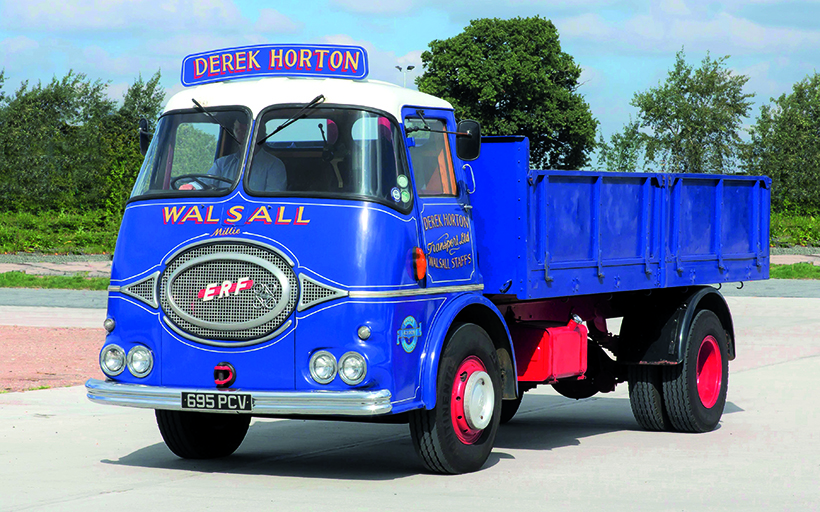
Derek Horton’s superbly restpored, 1962 ERF KV tipper.
When ERF introduced the KV (Kleer Vue) cab in the mid-1950s, it soon became an iconic design with its use of curved glass, and was popular with operators up and down the country. Many have survived into preservation, and all the major model manufacturers have included a KV in their catalogue. One of the ERF KVs chosen by Exclusive First Editions was 695 PCV, Derek Horton’s 1962 KV 64P tipper that’s been part of the rally scene for around 20 years, and has attended many events during that time.
But before we look in detail at the KV, it’s worth looking a little at Derek’s long association with road haulage, and the ERF marque in particular, which culminated in the restoration of 695 PCV. His father, also called Derek, started a coal business in Walsall, in 1961. “He ran Ford Thames Traders and, later, Ford D Series,” Derek said. “He would transport coal to Walsall from the mines in Yorkshire and South Wales, and also used a Thames Trader on his coal round in the town.”
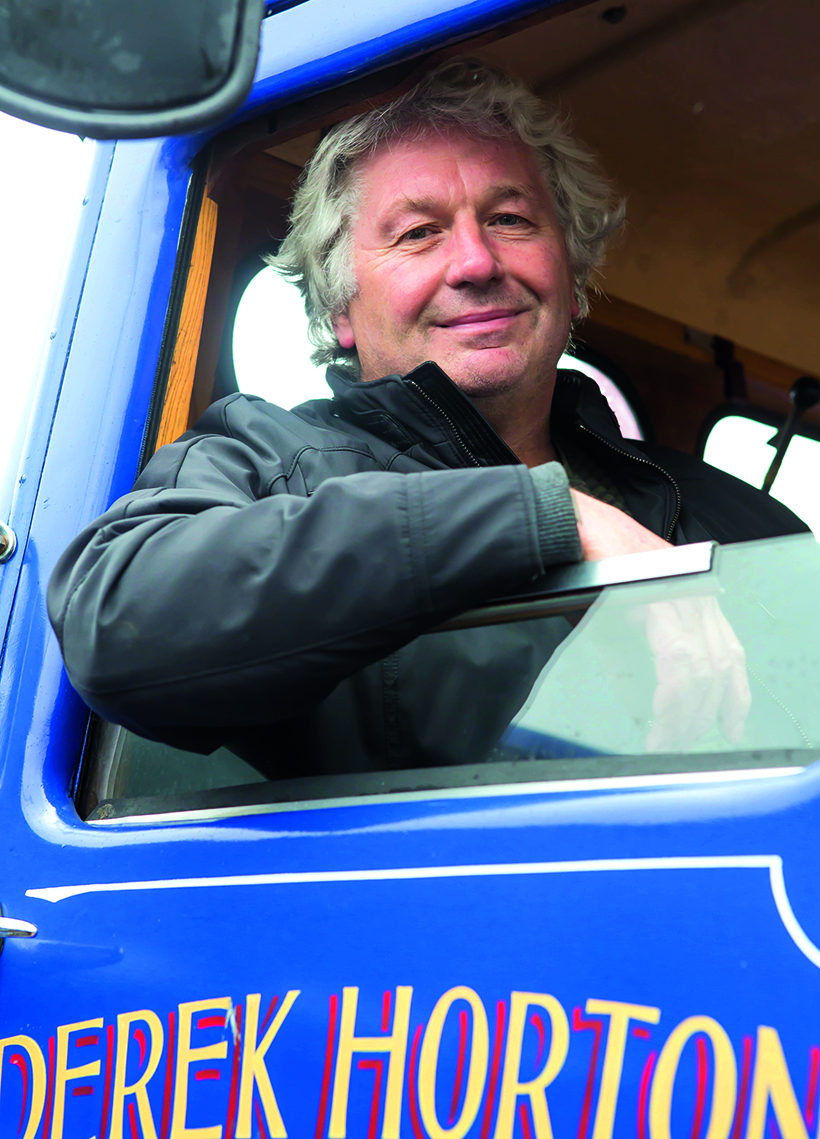
Young passenger!
Soon, a young Derek was accompanying his father on these trips. “I remember going to Ollerton to collect coke. I was about 10 at the time.” Derek also went out to collect coal with his uncle and other drivers. “They were early starts. We were always out of the yard by 4.30am.”
Unsrprisingly, when Derek left school aged 15, he joined the coal and haulage business, doing vehicle maintenance in the workshop. “I qualified as a mechanic at Walsall Technical College; it was a three-year course that I did on day-release, until I was 18.” But it wasn’t only maintenance that Derek was involved with. “I could drive a lorry by the age of 10,” he explained, “I started as soon as my feet could reach the pedals!” This meant that Derek would take charge of any internal vehicle movements in the yard, as well as driving lorries on work sites.

As found, the ERF KV sitting among some tyres in the yard at Perrins Commercials.
With all of this driving experience, it was only a matter of time before Derek obtained his full licence. “As soon as I passed my driving test, I was driving 7½ tonners.” The next step was to get his HGV Class 1. “I passed that 12 hours after my 21st birthday, and without having any lessons.” He was soon out on the road and, as things turned out, driving an ERF. “I was given a 1967 LV eight-wheeler but, after four weeks, one of my father’s drivers left, so I moved up to an LV artic.”
Going it alone
Before long, however, Derek decided to go it alone. “I started my own haulage business in 1978,” he said. With the help of some savings, and the proceeds of the sale of his beloved Ford Capri, he bought his first vehicle. “I went to have a look at two lorries at Oakley’s Transport of Hereford; one was an Atkinson Borderer and the other a 1969 ERF LV, registered NVJ 750G.” Derek took a test drive in both. “I preferred the ERF to the Atkinson,” Derek recalled. “Also, there was a local ERF dealership at Aldridge.” Accordingly, the LV was chosen. “I brush-painted the ERF into a blue livery and, 42 years later, I still run a fleet of blue tippers,” he said.
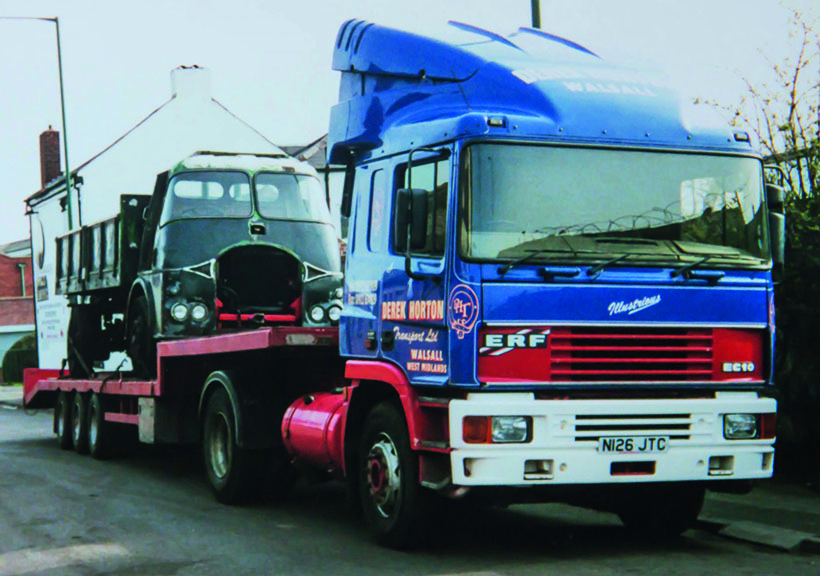
En route to its new home, courtesy of one of the E10s Derek was running at the time.
Derek continued to build up his fleet. “I scrapped the LV in 1980, and sold the engine for export to fund the next lorry. That was a Gardner 240-powered ERF A Series, registered JFL 222L, which was new to HE Musgrave of Lincolnshire.” After that ERF’s working days were over, it too was cut up and, again, the engine was exported. “That’s what was done in those days.”
The next vehicle to join the Horton fleet was ERF B Series, CEA 254T. “That was new to Kevin Fullard of Walsall, and was bought when it was three years old. I ran it for 20 years as a working lorry, sometimes double-shifted with two drivers so it was on the road day and night.”
With the business expanding during the 1980s and 1990s, more vehicles were bought. “I had one Seddon Atkinson 400 which was a good lorry but, unfortunately, the cab rotted away,” he continued. “We mainly ran a fleet of ERF B Series; I had a yard that was full of them.” He then moved on to C and E Series lorries. “ERFs were good servants to me,” Derek added.

Original – and unusual – the KV’s Perkins engine was retained.
Changing focus
The type of work being carried out was changing too. Initially, Derek worked on coal haulage, like his father. “Much of Walsall had no gas supply in those days, so people relied on coal for heating.” But when gas was put in, the coal business dwindled and, with a number of coal mines closing down, it was time to look for other work. “I decided to transfer from coal to hauling scrap,” Derek said, which is what he still does today. “We have done some container and low-loader work over the years, but have always run tippers.” Now the firm transports scrap metal to Liverpool and South Wales, from where it’s exported, or to Sheffield where it’s melted down.
The first new ERF arrived in 1998; that was an EC11 that was registered R22 DHT. “I bought several ERFs until production ceased,” he added, “These included a couple of ECs and ECXs.” As it turned out, the last two ERFs Derek bought are still on frontline service today, some 20 years on.
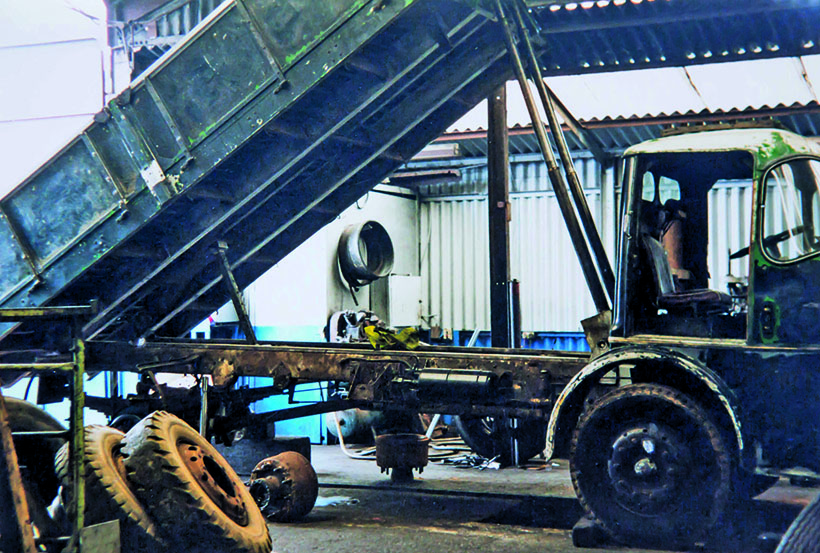
Paint preparation in progress.
Running older vehicles doesn’t bother Derek. “People call me the ‘Antiques Road Show’, but most of my drivers love them. I never worry about them getting home, but I can’t say the same about the modern, Euro 6 lorries that we run!” Now Derek runs three ERF ECXs, an ERF ECS and five Renault T range lorries, all hauling scrap.
But Derek’s real interest lies with older vehicles. “I just love them, they take me back to when I was a child, going out on my father’s coal lorries. Actually, I like anything on wheels.”
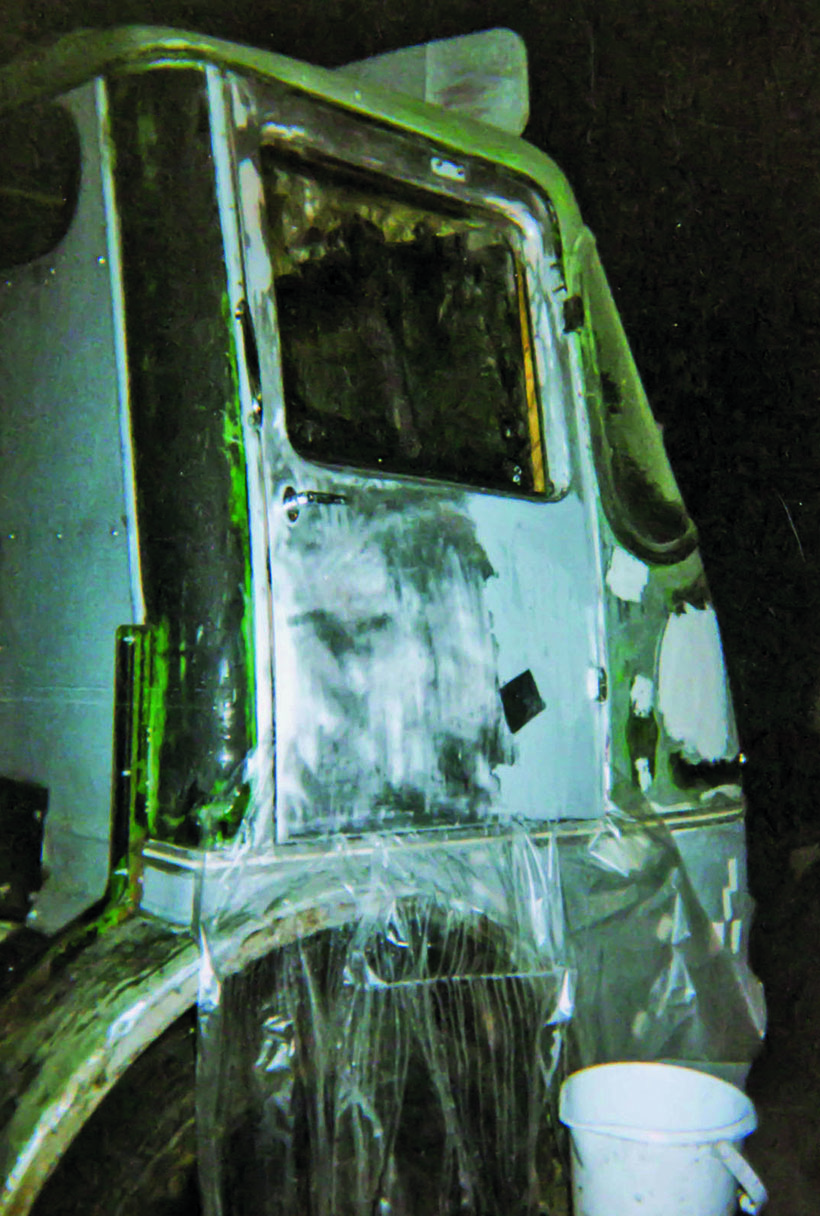
The cab being prepared after the wooden frame and doors had been repaired.
ERF KV arrives
So, in 1998, Derek decided to buy an old lorry; 695 PCV, his 1962 ERF KV 64P tipper. “I bought it from Perrins Commercials Ltd of Aldridge. They had got it from Worcester.” Derek knew Alan Perrins well. “I’d often visited the yard and bought parts,” Derek explained. He kept seeing this ERF KV standing in the yard. “It had been there for a while, surrounded by scrap tyres,” Derek confirmed So, eventually, he decided to buy it and was delighted with his purchase. “I had always wanted a KV, and the fact that it was a tipper was a bonus.”
The KV was new to Richards & Osborne of Fradden, in Cornwall, in 1962, and used on clay and brick haulage. “It travelled regularly from Cornwall up to the Midlands.” The logbook then states that it was with Frederick Leighton from Knighton on Teme, Tenbury Wells, although photos of the ERF in Perrins’ yard show the name of ‘PC Attfiel’ on the door.
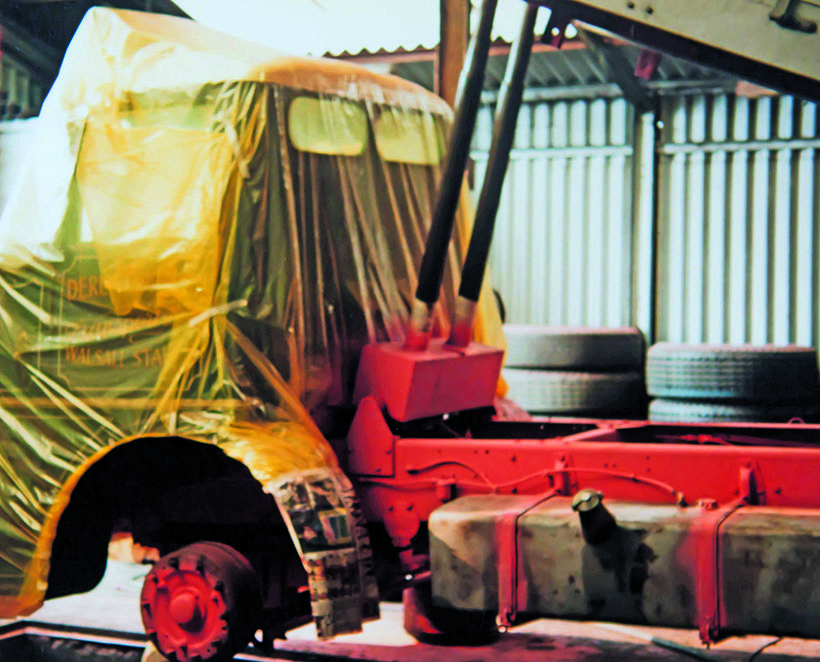
The cab completed and covered as chassis is painted.
With the KV now back in Derek’s yard, thoughts turned to the vehicle’s restoration. “When I looked at the cab, I soon realised that repairing rotten timberwork was beyond my capabilities,” he admitted. Specialist help was needed. “I got the late Stuart Bebbington to reconstruct the cab for me. He made new ash door frames and re-fitted the original skins.” Some work was also required on the ash cab frame which was repaired and replaced as required. Stuart also recovered the seats and fitted new plywood floor panels.
Stuart was well-qualified to do the work on the cab as he had worked for JH Jennings & Sons (as in Jennings Cabs) of Sandbach. Jack Rowley, who brush-painted the cab as well as completing the sign-writing, had also worked there. “I wanted a working appearance, and think that brush-painting achieves that.”

The cab completed and awaiting its new ‘oval’.
Part-time restoration
The remainder of the KV’s restoration was carried out by Derek with colleague, Clive Read. “We did it in my workshop between jobs,” he said. There was a fair bit to do, although there was good news when it came to the chassis. “It was in really good shape. All we did was rub it down by hand before repainting it.” It was a similar story with the tipping gear. “That was fine as well,” he said, “and I didn’t need to do anything to it.”
Work that was required included renewing the body top rails, kingpins, bushes and shackles, The brakes also needed overhauling, and Derek fitted a reconditioned, brake servo and diaphragms.” A few other issues also needed attention. “The fuel tank was beyond repair, so I installed one that came from an old Ford lorry, and we had to fit two, new front tyres.”
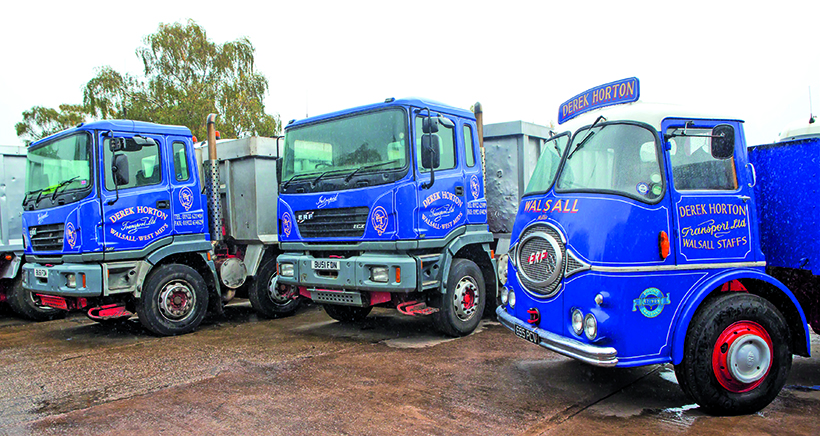
The old and the new in Derek’s fleet.
Unusually, this ERF has a Perkins engine. The original build sheet clearly says that a Perkins six-354D engine was ordered by Richards & Osborne. Derek doesn’t know why they wanted this, but that engine remains in place to this day. “Although it’s worn, I’ve only serviced it, and it’s been fine so far.”
The whole restoration took about four years of part-time work. “I then started to attend a few rallies,” Derek said. But a few problems started to emerge. “The two-speed rear axle was a bit ropey and, eventually, the differential went. “The two-speed axle kept dropping out of gear but, because the fault was only there for a brief moment, tracing the cause was difficult. I didn’t know if it was the differential or the gearbox.”
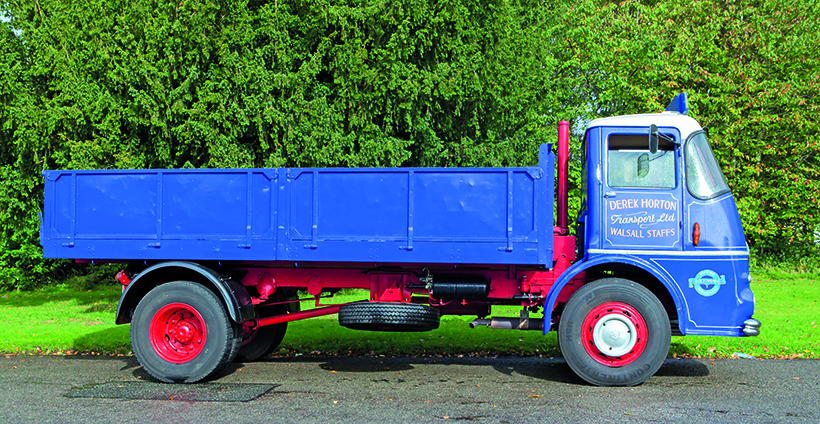
But the mystery was solved when Derek was attending a rally at The New Hollies, on the A5. “When I went to leave, it wouldn’t drive. So, I dropped down to low-ratio and away it went at a stately 36mph.” The answer was to fit a reconditioned unit. “That one had a higher speed ratio, so was actually better when I took the KV to shows,” Derek added.
A regular at shows
The ERF has been regularly exhibited since. “I attend local events as well as some that are further afield, such as the ERF gathering at Kelsall.” He’s always looking to give the lorry a working appearance. “When I needed new sideboards, I thought about fitting greedy boards, but I’ve decided against doing that for now.”
Derek has also met his ERF’s original driver, a Mr Ivor Daniels, who collected it from the factory when new. “He told me that he picked up the KV as a chassis cab, then stopped on the way back down to Cornwall and waited while the tipping body was fitted, before completing the trip.” Ivor had other memories of the KV. “The regular trips up to the Midlands were three-day round trips.” Ivor was delighted to see the ERF in its fully-restored state, and went out for a drive in it with Derek. “Before we set off he said: ‘I remember it being a noisy bugger,’ I had to laugh and tell him that it was still the same.”
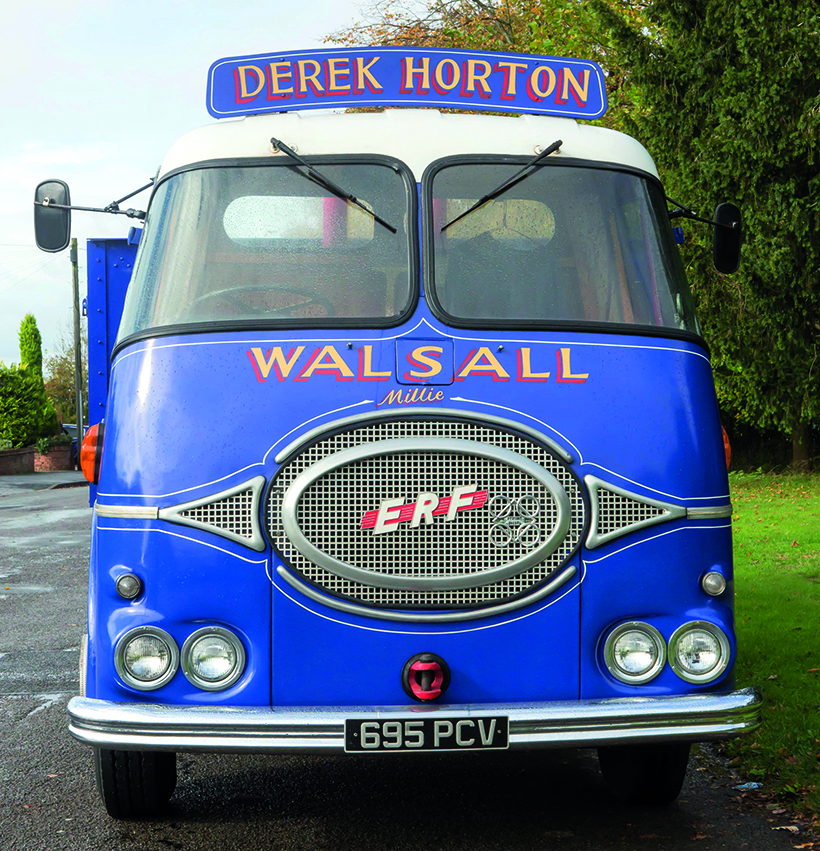
In 2007, Exclusive First Editions decided to release a model of Derek’s ERF. “EFE just asked me to send photos for them to work from,” Derek continued.
But the KV isn’t the only vehicle that’s seen some restoration, though. “I have an AEC Matador that my father bought when I was eight years old,” Derek continued. “It’s an ex-RAF vehicle that came out of Ruddington to a garage in Walsall Wood, from where my dad brought it. It worked until the late 1960s/early 1970s, and I rode ‘shot gun’ on one trip to Cornwall,” Derek remembered, “It was a long way.” The journey began at 5am, with the AEC arriving at 11pm that night. “We were towing a broken-down lorry for a local haulage firm,” Derek said. Towards the end of the journey, Derek took a turn at the wheel. “I remember doing the last 50 miles or so with a bulge the size of a rugby ball in one of the tyres,” he said, “I had to keep going as we weren’t carrying a spare.” The AEC has been in the Horton fleet for over 50 years, and has stood in the yard for much of that time, although some renovation work has been done. “I’ve been restoring it for around 30 years,” Derek concluded.
But for now, it is the KV that’s continuing to be seen on the rally scene. It’s certainly not the newest restoration on the circuit, but remains in great condition considering the amount of time that it’s been around.

For a money-saving subscription to Classic & Vintage Commercials magazine, simply click here





